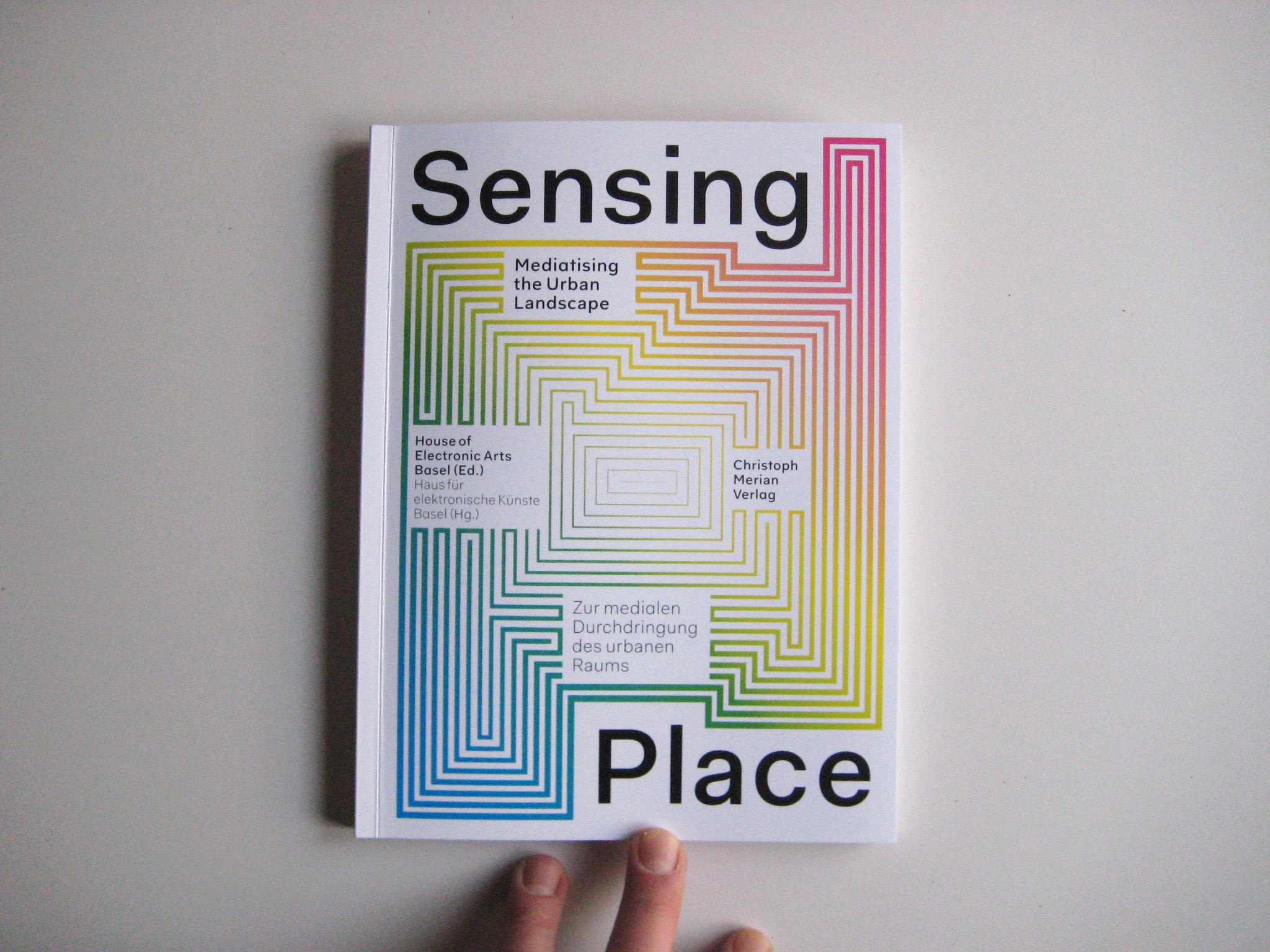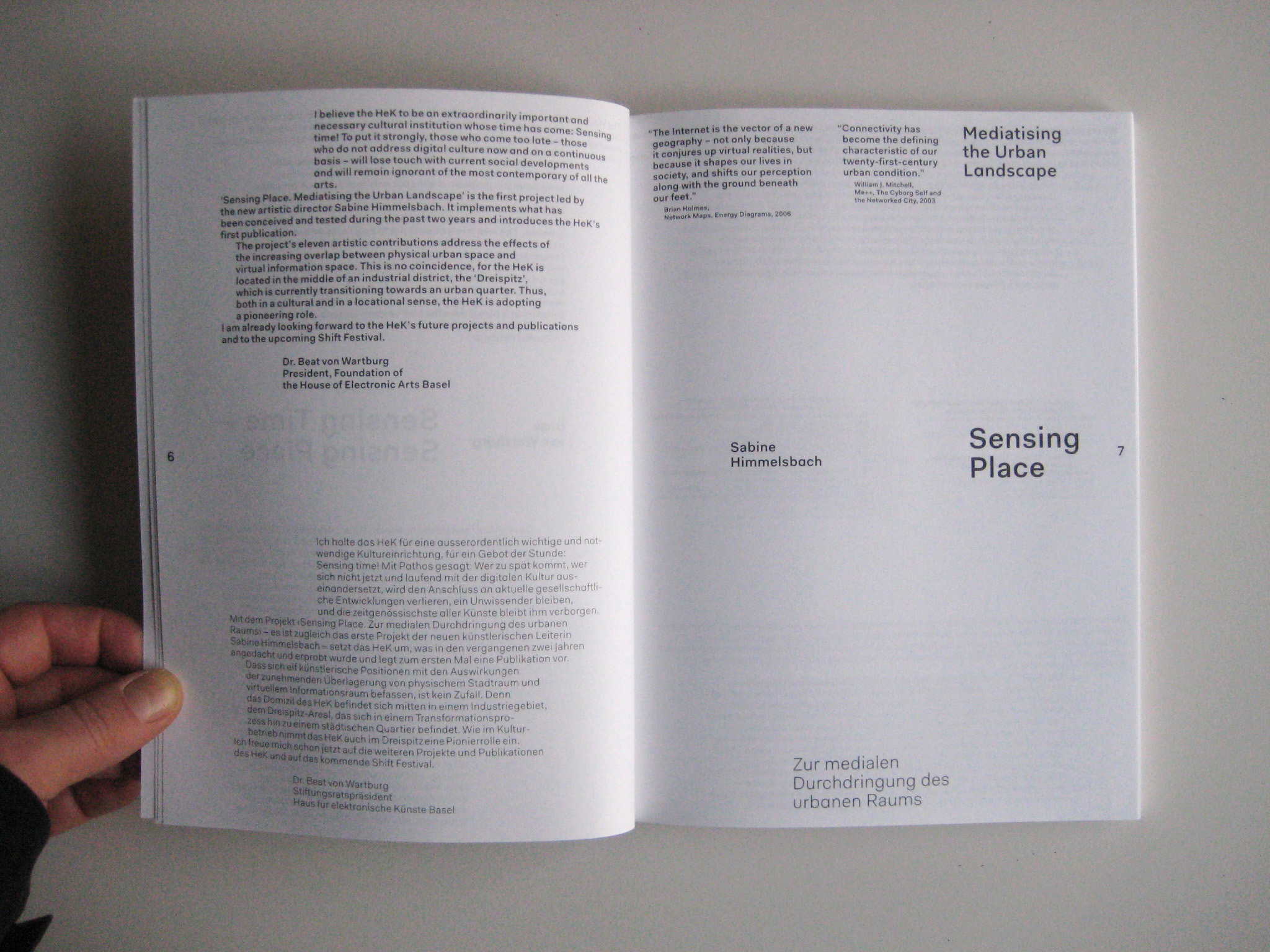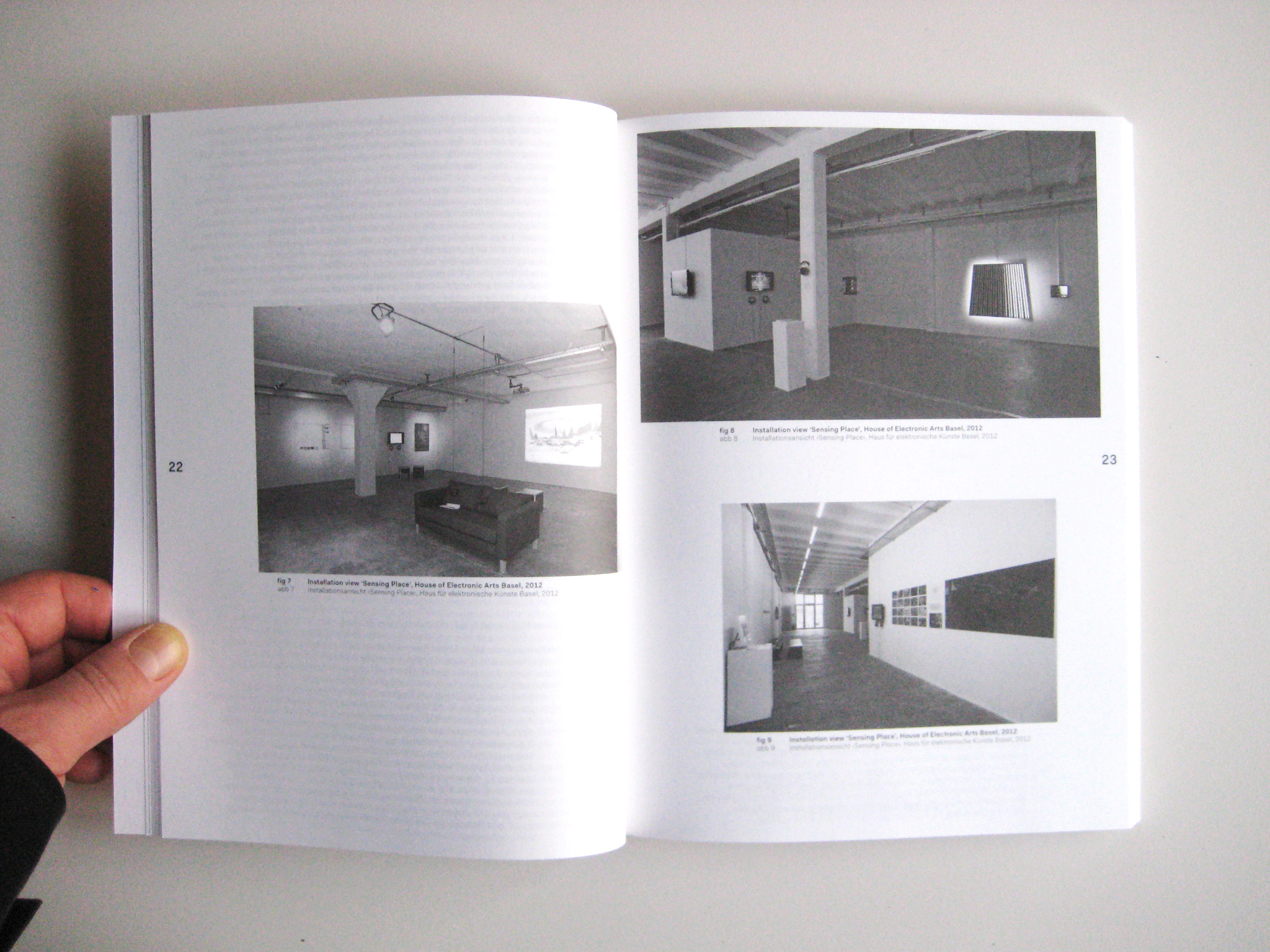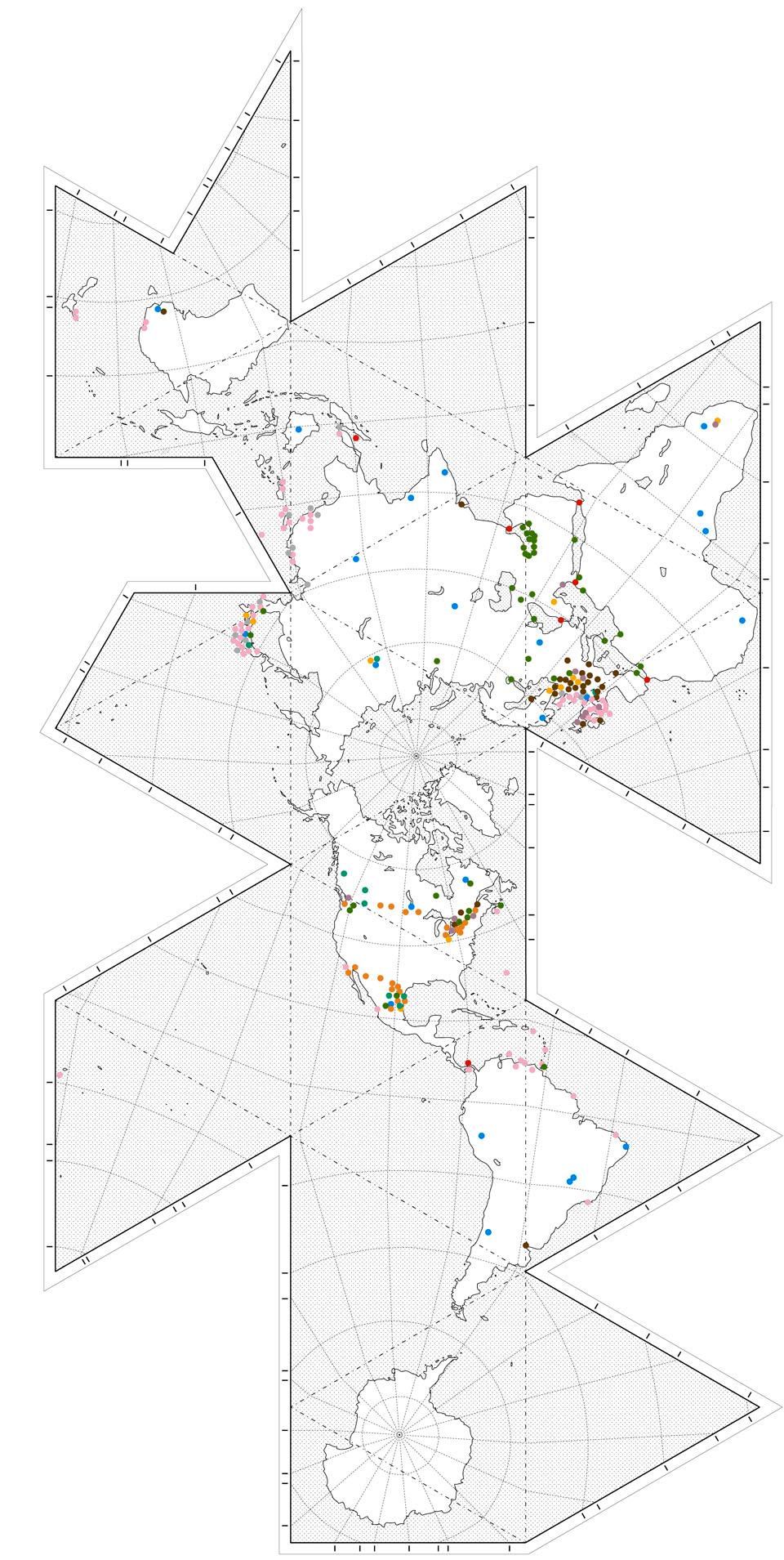Monday, August 12. 2013
Via ericsadin.org via Le Monde
-----
Following all these recent posts aboutths nsa, algorithms, surveillance/monitoring, etc., I take here the opportunity to reblog what our very good friend Eric Sadin published in Le Monde last month about this question (the article is only in French, it was following the publication of a new book by Eric: L'humanité augmentée - L'administration numérique du monde -, éd. L'échapée). It is also the occasion to remind that we did a work in common about this last year, Globale surveillance, that will be on stage again later this year!
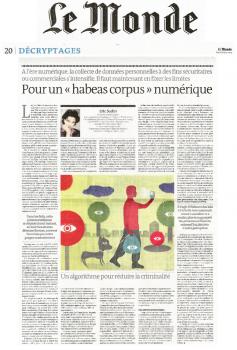
Le 5 juin, Glenn Greenwald, chroniqueur au quotidien britannique The Guardian, révèle sur son blog que l'Agence de sécurité nationale (NSA) américaine bénéficie d'un accès illimité aux données de Verizon, un des principaux opérateurs téléphoniques et fournisseurs d'accès Internet américains. La copie de la décision de justice confidentielle est publiée, attestant de l'obligation imposée à l'entreprise de fournir les relevés détaillés des appels de ses abonnés. "Ce document démontre pour la première fois que, sous l'administration Obama, les données de communication de millions de citoyens sont collectées sans distinction et en masse, qu'ils soient ou non suspects", commente-t-il sur la même page.
Dès le lendemain, Glenn Greenwald relate dans un article cosigné avec un journaliste du Guardian d'autres faits décisifs : neuf des plus grands acteurs américains d'Internet (Google, Facebook, Microsoft, Apple, Yahoo, AOL, YouTube, Skype et PalTalk) permettraient au FBI (la police fédérale) et à la NSA d'avoir directement accès aux données de leurs utilisateurs, par le biais d'un système hautement sophistiqué baptisé "Prism", dont l'usage régulier serait à l'oeuvre depuis 2007. Informations confidentielles à l'origine livrées par Edward
Snowden, jeune informaticien ex-employé de l'Agence centrale du renseignement (CIA), officiant pour différents sous-traitants de la NSA. Le "lanceur d'alerte" affirme que de telles pratiques mettent en péril la vie privée, engageant en toute conscience son devoir de citoyen de les divulguer, malgré les risques de poursuites encourues. Les entreprises incriminées ont aussitôt démenti cette version, laissant néanmoins supposer que des négociations sont en cours en vue de créer un cadre coopératif "viable" élaboré d'un commun accord.
Divulgations qui ont aussitôt suscité un afflux de commentaires de tous ordres, relatifs à l'ampleur des informations interceptées par les agences de renseignement, autant qu'à l'impérieuse nécessité de préserver les libertés individuelles.
S'il demeure de nombreuses zones d'ombre et des incertitudes quant aux procédés employés et à l'implication de chacun des acteurs, ces affaires confirment manifestement, aux yeux du monde, qu'un des enjeux cruciaux actuels renvoie à l'épineuse question de la récolte et de l'usage des données à caractère personnel. Ces événements, s'ils sont confirmés dans leur version initiale, sont éminemment répréhensibles, néanmoins, pour ma part, je ne veux y voir qu'une forme de "banalité de la surveillance contemporaine", qui dans les faits se déploie à tout instant, en tout lieu et sous diverses formes, la plupart du temps favorisée par notre propre consentement.
Car ce qui se joue ici ne relève pas de faits isolés, principalement "localisés" aux Etats-Unis et conduits par de seules instances gouvernementales, dont il faudrait s'offusquer au rythme des révélations successives. C'est dans leur valeur symptomale qu'ils doivent être saisis, en tant qu'exemples de phénomènes aujourd'hui globalisés, rendus possibles par la conjonction de trois facteurs hétérogènes et concomitants. Sorte de "bouillon de culture" qui se serait formé vers le début de la première décennie du XXIe siècle, et qui a "autorisé" l'extension sans cesse croissante de procédures de surveillance, suivant une ampleur et une profondeur sans commune mesure historique.
D'abord, c'est l'expansion ininterrompue du numérique depuis le début des années 1980, plus tard croisée aux réseaux de télécommunication, qui a rendu possible vers le milieu des années 1990 la généralisation d'Internet, soit l'interconnexion globalisée en temps réel.
Ensuite, l'intensification de la concurrence économique a encouragé l'instauration de stratégies marketing agressives, cherchant à capter et à pénétrer toujours plus profondément les comportements des consommateurs, un objectif facilité par la dissémination croissante de données grâce au suivi des navigations, ou autres achats par cartes de crédit ou de fidélisation.
Enfin, les événements du 11 septembre 2001 ont contribué à amplifier un profilage sécuritaire indifférencié du plus grand nombre d'individus possible. Ce qui est désormais nommé " Big Data ", soit la profusion de données disséminées par les corps et les choses, se substitue en quelque sorte à la figure unique et omnipotente de Big Brother, en une fragmentation éparpillée de serveurs et d'organismes, qui concourent ensemble et séparément à affiner la connaissance des personnes, en vue d'une multiplicité de fonctionnalités à exploitations prioritairement sécuritaires ou commerciales.
Le lien charnel, tactile ou quasi ombilical que nous entretenons avec nos prothèses numériques miniaturisées - particulièrement emblématique dans le smartphone - bouleverse les conditions historiques de l'expérience humaine. La géolocalisation intégrée aux dispositifs transforme ou "élargit" notre appréhension sensorielle de l'espace ; la portabilité expose une forme d'ubiquité induisant une perception de la durée au rythme de la vitesse des flux électroniques reçus et transmis ; les applications traitent des magmas d'informations à des vitesses infiniment supérieures à celles de nos capacités cérébrales, et sont dotées de miraculeux pouvoirs cognitifs et suggestifs, qui peu à peu infléchissent la courbe de nos quotidiens.
C'est un nouveau mode d'intelligibilité du réel qui s'est peu à peu constitué, fondé sur une transparence généralisée, qui réduit la part de vide séparant les êtres entre eux et les êtres aux choses. "Tournant numérico-cognitif" engendré par l'intelligence croissante acquise par la technique, capable d'évaluer les situations, d'alerter, de suggérer et de prendre dorénavant des décisions à notre place (à l'instar du récent prototype de la Google Car, ou du trading à haute fréquence).
Le mouvement généralisé de numérisation du monde, dont Google constitue le levier principal, vise à instaurer une "rationalisation algorithmique de l'existence", à redoubler le réel logé au sein de "fermes de serveurs" hautement sécurisées, en vue de le quantifier et de l'orienter en continu à des fins d'"optimisation" sécuritaire, commerciale, thérapeutique ou relationnelle. C'est une rupture anthropologique qui actuellement se trame par le fait de notre condition de toute part interconnectée et robotiquement assistée, qui s'est déployée avec une telle rapidité qu'elle nous a empêchés d'en saisir la portée civilisationnelle.
Les récentes révélations mettent en lumière un enjeu crucial de notre temps, auquel nos sociétés dans leur ensemble doivent se confronter activement, devant engager à mon sens trois impératifs éthiques catégoriques. Le premier consiste à élaborer des lois viables à échelles nationale et internationale, visant à marquer des limites, et à rendre autant que possible transparents les processus à l'oeuvre, souvent dérobés à notre perception.
Dimensions complexes dans la mesure où les développements techniques et les logiques économiques se déploient suivant des vitesses qui dépassent celle de la délibération démocratique, et ensuite parce que les rapports de force géopolitiques tendent à ralentir ou à freiner toute velléité d'harmonisation transnationale (voir à ce sujet la récente offensive de lobbying américain cherchant à contrarier ou à empêcher la mise en place d'un projet visant à améliorer la protection des données personnelles des Européens : The Data Protection Regulation - DPR - ).
Le deuxième requiert un devoir d'enseignement et d'apprentissage des disciplines informatiques à l'école et à l'université, visant à faire comprendre "de l'intérieur" les fonctionnements complexes du code, des algorithmes et des systèmes. Disposition susceptible de positionner chaque citoyen comme un artisan actif de sa vie numérique, à l'instar de certains hackeurs qui en appellent à comprendre les processus à l'oeuvre, à se réapproprier les dispositifs ou à en inventer de singuliers, en vue d'usages "libres" et partagés en toute connaissance des choses.
Le troisième mobilise l'enjeu capital visant à maintenir une forme de "veille mutualisée" à l'égard des protocoles et de nos pratiques, grâce à des initiatives citoyennes s'emparant sous de multiples formes de ces questions, afin de les exposer dans le domaine public au fur et à mesure des évolutions et innovations successives. Nous devons espérer que l'admirable courage d'Edward Snowden ou la remarquable ténacité de Glenn Greenwald soient annonciateurs d'un "printemps globalisé", appelé à faire fleurir de toute part et pour le meilleur les champs de nos consciences individuelles et collectives.
Citons les propos énoncés par Barack Obama lors de sa conférence de presse du 7 juin : "Je pense qu'il est important de reconnaître que vous ne pouvez pas avoir 100 % de sécurité, mais aussi 100 % de respect de la vie privée et zéro inconvénient. Vous savez, nous allons devoir faire des choix de société." Dont acte, et sans plus tarder.
A l'aune de l'incorporation annoncée de puces électroniques à l'intérieur de nos tissus biologiques, qui témoignerait alors sans rupture spatio-temporelle de l'intégralité de nos gestes et de la nature de nos relations, la mise en place d'un "Habeas corpus numérique" relève à coup sûr d'un enjeu civilisationnel majeur de notre temps.
Eric Sadin
© Le Monde
Tuesday, December 04. 2012
Via Cabinet
-----
By Nicola Twilley
More than three-quarters of the food consumed in the United States today is processed, packaged, shipped, stored, and sold under artificial refrigeration. The shiny, humming stainless steel box in your kitchen is just the tip of the iceberg, so to speak—a tiny fragment of the vast global network of temperature-controlled storage and distribution warehouses cumulatively capable of hosting uncounted billions of cubic feet of chilled flesh, fish, or fruit. Add to that an equally vast and immeasurable volume of thermally controlled space in the form of shipping containers, wine cellars, floating fish factories, international seed banks, meat-aging lockers, and livestock semen storage, and it becomes clear that the evolving architecture of coldspace is as ubiquitous as it is varied, as essential as it is overlooked.
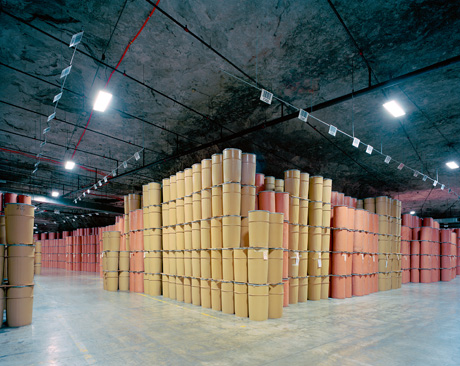
(...)
More about it and about a "perpetual winter" on Cabinet's website.
Monday, November 05. 2012
Via MIT Technology Review
-----
Using technology to cool the planet may be the only way to deal with the greenhouse gases already in the atmosphere, argues scientist David Keith.
By Kevin Bullis

David Keith spoke at MIT Technology Review’s EmTech conference this week.
Geoengineering—using technology to purposefully change the climate—is the only option for reducing the risk of climate change from greenhouse-gas emissions in the next few decades, says David Keith, a professor of public policy and applied physics at Harvard University. And he says that if it’s done in moderation, it could be much safer than some experts have argued. In fact, says Keith, effective methods of geoengineering are so cheap and easy that just about any country could do it—for better or worse.
Keith, speaking this week at MIT Technology Review’s annual EmTech conference, says it is already too late to avoid climate changes by reducing carbon emissions alone. The carbon dioxide that’s been released into the atmosphere by burning fossil fuels is already likely to cause significant harm, such as raising temperatures enough to hurt crop yields in many places. “If you want to, say, really stop the loss of Arctic sea ice or stop heat-stress crop losses over the next few decades, geoengineering is pretty much the only thing you can do,” he says (see “Why Climate Scientists Support Geoengineering Research”).
Keith’s preferred method of geoengineering is to shade the earth by injecting sulfate particles into the upper atmosphere, imitating a similar process that happens with large volcanic eruptions, which are known to temporarily cool the planet. The technique could be effective even if far less sulfate were injected than is currently emitted by fossil-fuel power plants. A million tons per year injected into the stratosphere would be enough—whereas 50 million tons are injected into the lower part of the atmosphere by coal plants, he says. (In the lower atmosphere, the sulfates are less effective at cooling because they stay airborne for shorter periods.)
One of the main objections to geoengineering is that the measures that might be taken to cool the planet won’t exactly offset the effects of carbon dioxide, so they could actually make things much worse—for example, by altering patterns of precipitation. Keith says recent climate models suggest that injecting sulfate particles into the upper reaches of the atmosphere might not affect precipitation nearly as much as others have warned.
“I propose that you start in about 2020, and you start very, very gradually increasing your amount of sulfate engineering so that you cut about in half the rate of warming,” he says. “Not eliminate it, but cut it about in half. Cutting it in half is a big benefit.”
One of the benefits could be increased crop production. Though some critics have worried that geoengineering would alter monsoon patterns that are key to agriculture in India, Keith says moderate geoengineering could actually boost crop productivity there by 20 percent, in part by reducing temperatures.
Keith and some of his colleagues recently hired engineers to estimate how much one approach to sulfate injection might work, and how much it might cost. It could be done at first with existing airplanes—certain business jets can fly high enough to inject the particles into the upper atmosphere. Eventually we would need new planes that can fly higher. All in all, once the procedure is scaled up it would cost about a billion dollars a year and require about 100 aircraft. That’s cheap enough for most countries to pull off on their own.
The fact that it’s easy isn’t necessarily a good thing, Keith says. There’s the potential that if one country does it, another might blame that country—rightly or wrongly—for ensuing bad weather (see “The Geoengineering Gambit”).
And there are also real concerns about the impact sulfates might have on the atmosphere (see Geoengineering May Be Necessary, Despite Its Perils). It’s known that sulfates can be involved in reactions that deplete the ozone layer. As the earth warms, water vapor levels are increasing, which could exacerbate the problem. Keith is proposing a test to discover quantitatively just what the effect of the injections could be. He would introduce small clouds of sulfate and water vapor into the stratosphere using balloons, and then carefully measure the reactions that take place.
And Keith acknowledges a concern many have had about geoengineering: that using it to offset problems from climate change will reduce the incentive to tackle the greenhouse-gas emissions at the root of the problem. Even if geoengineering is employed, reducing emissions will still be important. Sulfate injection does nothing to address the ocean acidification associated with increased levels of carbon dioxide in the atmosphere. And if emissions continue to grow, ever-increasing amounts of sulfate will be needed.
But Keith thinks the potential benefits might be worth the dangers. “We don’t know enough yet to start,” he says. “But the current balance of evidence is that doing this really would reduce risks. And for that reason, we’ve got to take it seriously. It really would be reckless not to look at something that could reduce risk like this could.”
Saturday, September 01. 2012
Monday, June 04. 2012
-----
by rholmes
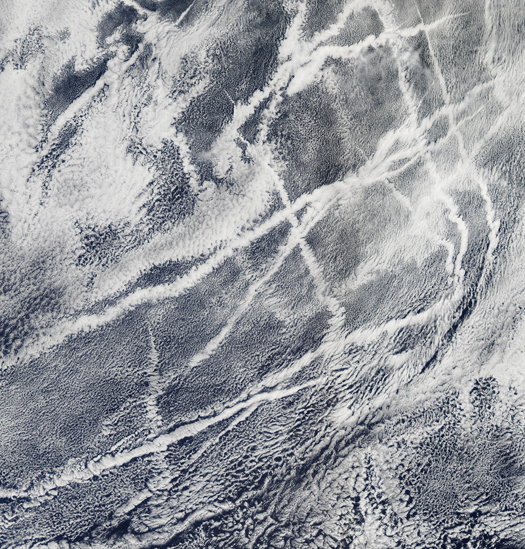
[Ship tracks -- "narrow clouds... form[ed] when water vapor condenses around tiny particles of pollution that ships either emit directly as exhaust or that form as a result of gases within the exhaust” — in the Pacific Ocean off the coast of California, captured photographically by a NASA satellite; the atmospheric trace of the seaborne transfer of goods and materials between East and West.]
Thursday, July 28. 2011
Via MIT Technology Review
-----
Powerful design tools and techniques such as 3-D printing enable manufacturers to be more nimble, says Autodesk's manufacturing boss.
By Tom Simonite
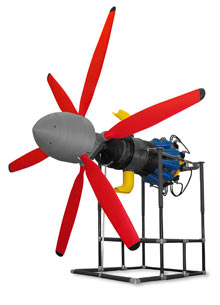 |
3-D printing: A 3-D printer squirted out each of the 200 plastic parts in this 10-foot-long turbo-prop engine, demonstrating a technology that could soon be used for more than just prototyping.
Credit: Autodesk |
Autodesk, a multinational software company based in San Rafael, California, makes 3-D design software used by everyone from automotive manufacturing giants to Hollywood studios. Now it is betting that those digital tools will have an increasingly powerful role in what happens on factory floors, enabling manufacturers to embrace more flexible strategies that deliver more customized products.
Buzz Kross, who heads the company's manufacturing industry group, says the manufacturers he works with see an opportunity in new technology at a time when they sense that the boom in outsourcing to China has run its course. "There have always been companies that differentiate based on their ability to manufacture most efficiently, and others based on design and invention—it's the difference between GM and Tesla," says Kross. "Now a lot of manufacturers are leaning more to the design model."
Kross says that rising costs in China's maturing economy and high-profile problems with out-sourced components, like those that plagued Boeing's 787, are making the model of high-volume, low-cost outsourced production less economically attractive. The result is that a wider range of companies are considering adopting a more flexible, premium approach to manufacturing that has previously been limited to a relatively small niche. Kross is trying to help that trend along with software such as Inventor, which provides a way to digitally prototype and test mechanical designs, and Streamline, which enables engineers, designers, and managers to collaborate on a design. Both are intended to speed the journey from digital drawing board to factory floor.
"You don't need to center everything on making millions of the same thing at the absolute cheapest price anymore," says Kross. He cites the growing popularity of a model known as ETO (engineer to order), in which businesses buying from manufacturers order by referring to a list of general rules, not a catalogue and price list. For each order, a manufacturer makes and assembles a product very specific to the customer's needs. That approach also cuts costs, because raw materials and parts don't have to be held in stock; rather, they can be purchased to match the latest order. And the customized products can command a higher price than a conventionally made one, Kross says: "These companies capture a larger share of the customer's wallet this way."
That style of manufacturing makes the design process—and design software—much more central. Kross says that 3-D printing technology will blur the line between design and manufacturing still further.
"Everybody's already embracing it for prototyping," says Kross. "You can already print moving components and subassemblies that don't need any assembly. That's incredibly useful, whether you make pumps or power trains or chairs." Nike, an Autodesk customer, prototypes shoes by using a printer to squirt out materials that have more or less compressibility, depending on how bouncy and flexible each part of the sole is meant to be.
The next step is for 3-D printing to become a manufacturing method rather than solely a prototyping tool, says Kross. Small companies are already trying this, but it won't be long before large manufacturers follow suit. "Think about when you buy a Dell computer and they let you choose all the different components," Kroll says. "3-D printing for manufacturing will allow you to have that, but with nearly infinite options."
This process may cost manufacturers more than production at a more conventional or offshore factory. But as with the ETO approach, more customized products fetch higher prices, says Kroll. Jewelry, furniture, and consumer electronics are all areas that could benefit from the new techniques, he says. "People don't like it when they have the same thing as everything else and will pay more to get exactly what they choose."
Copyright Technology Review 2011.
Personal comment:
We are just ending the beta version of a project where we used Inventor to pre-assemble, then laser cut and fold all the parts of the object. Like many of us now. Well, then this is still not an easy process... and our object remain relatively small. But when the softwares and machines will become efficient enough from sketching to building (possibly Revit with its BIM model --to which should be added some strong scripting and design options--), through prototyping, these will truely become powerful design tools opening up to a new design paradigm.
And its interesting to underline the fact that this way of producing could also be taken into account for a sustainable design approach.
Friday, July 08. 2011
Via Information aesthetics
-----
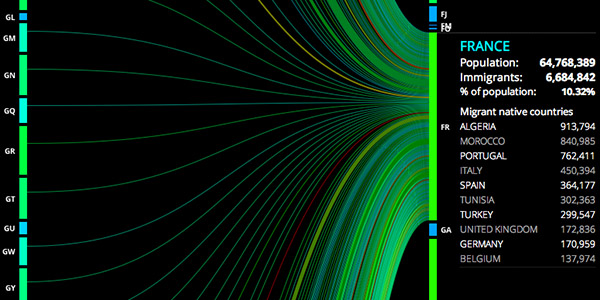
About 3% of the world's population does not live in their native countries, including those that can be classified as refugees or asylum seekers. People Movin [peoplemov.in] by Carlo Zapponi is a simple but oh-so-beautiful and still effective interactive graph that highlights all these migration patterns in the world as of the year 2010 in one single view.
Based on open datasets from the World Bank and the U.S. Census Beurau Bureau, the migration data is represented as one, large flow chart that connects the origin countries (left) with the destination countries (right). The relative thickness of each line represents the amount of immigrated people. Countries can be selected in the 2 columns, or in the small windows that pop up to provide more detailed information.
Well, there is that plus the website is actually also the result of developing a flow chart visualization framework based on HTML5 technologies.
See also Mapping the Immigration and Emigration Patterns of New Yorkers.
Tuesday, June 21. 2011
Via BLDGBLOG
-----
by noreply@blogger.com (Geoff Manaugh)
A recent article of mine for Domus, on the "critical foreign dependencies" list revealed last winter by Wikileaks, is now online, in case you missed it here, complete with some maps and infographics.
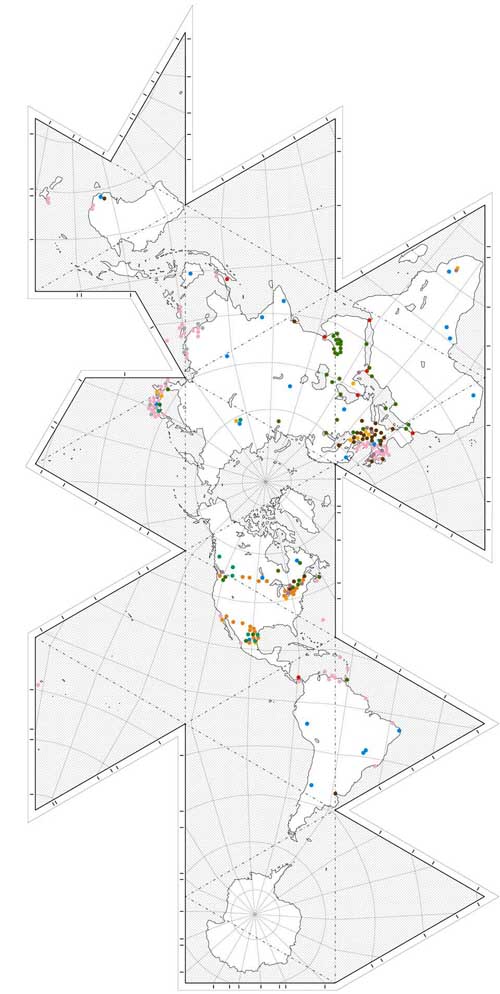 [Image: Map by, and courtesy of, Domus, "in homage to Buckminster Fuller’s famous Dymaxion projection, and showing the locations of 259 critical infrastructures"; see it folded up, courtesy of David M.A.].
Check it out [Image: Map by, and courtesy of, Domus, "in homage to Buckminster Fuller’s famous Dymaxion projection, and showing the locations of 259 critical infrastructures"; see it folded up, courtesy of David M.A.].
Check it out if you get a chance—and thanks again to Domus for the opportunity to explore this topic.
Personal comment:
Beside the topic that tells us that a country as a lot of distributed crucial interests outside its own borders, which modifies the idea of nation's territory, I also like the fact that it is shown on Buckminster Fuller's map that describes an Earth made out of connected and nearly continuous lands and archipelagoes, connected through the Arctic...
Thursday, May 26. 2011
Via Fubiz
-----
by Versa
Le photographe Terence Chang parvient avec talent à prendre et capter les lumières des avions et propose une série de clichés autour des tracés de lumières. Illustrant des lumières dans le ciel, ces visuels capturés à San Francisco sont à découvrir dans la suite.
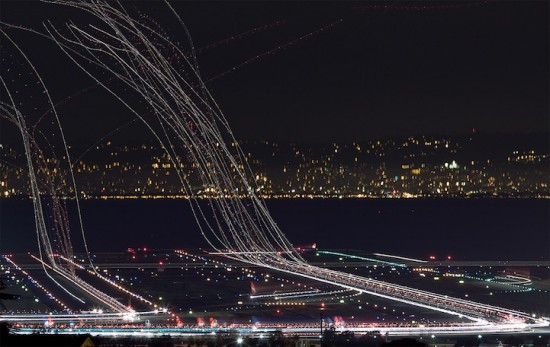
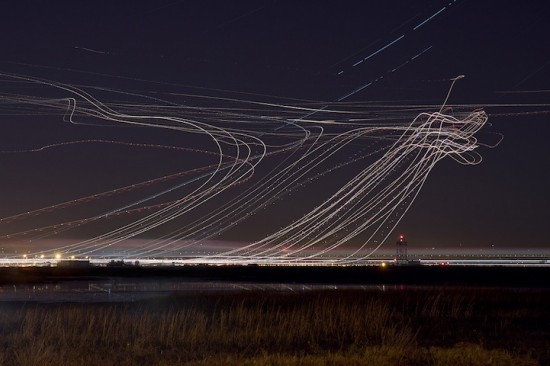
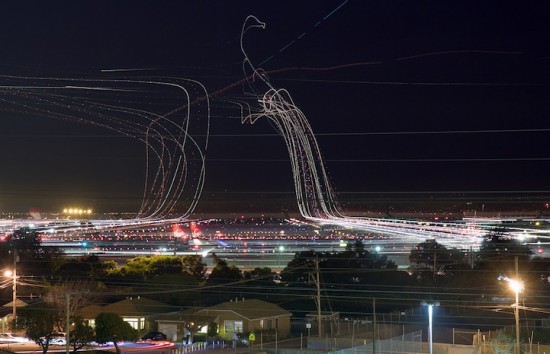
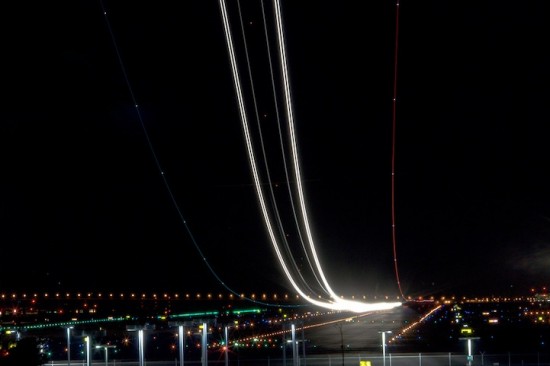
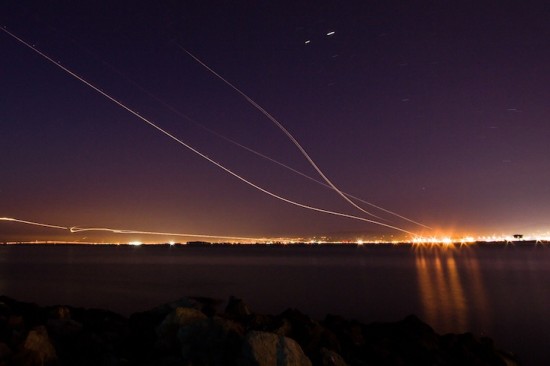
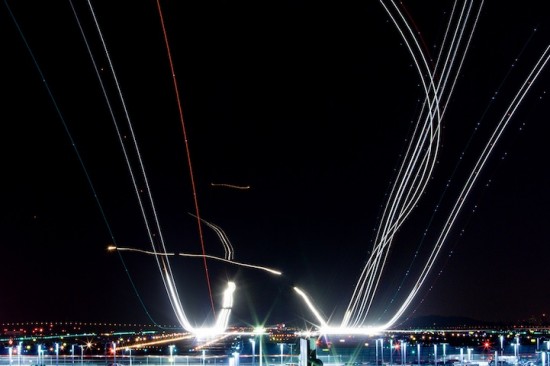

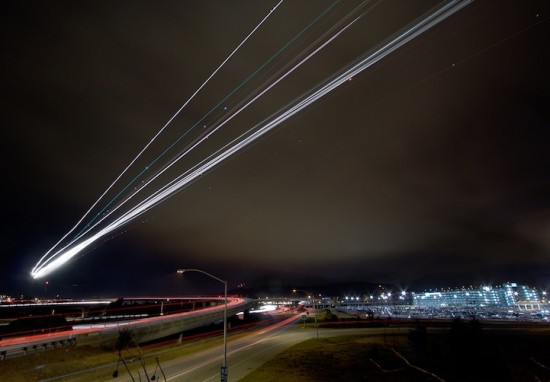
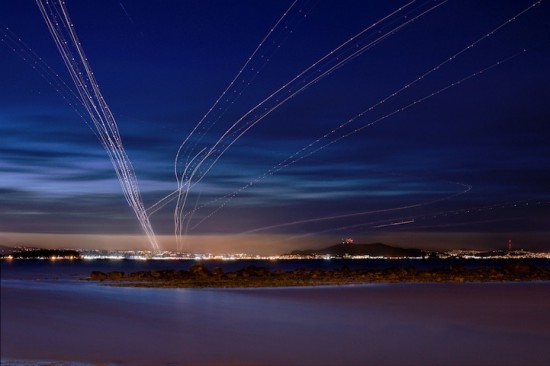
Personal comment:
We've seen this for cars, but with cars it is slightly different: they are on the road that already has a shape. In the case of long exposure with planes, we see invisible shapes and "luftbahns"... Some shapes of global & physical mobility.
Monday, April 11. 2011
Via Treehugger
-----
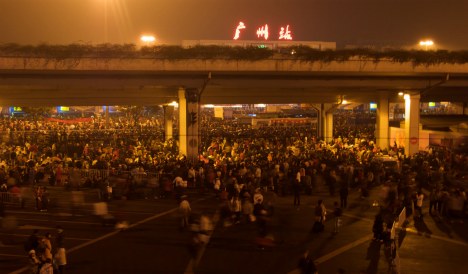
Crowds gather at Guangzhou Railway Station for the New Year exodus in 'Last Train Home.' Image: Zeitgeist Films
Every year, 130 million people throng China's railway stations, frantically trying to obtain a seat on a train that will take them home for the lunar New Year -- a trip that is for many rural people living and working in the country's industrial cities their only chance to see the families, and even the children, they have left behind. In addition to the human drama, the trek, believed to constitute the largest human migration in the world, taxes the country's transportation systems to the limit.
The chaos at the train stations, the stark difference between urban and rural China, and the alienation among families of economic migrants are strikingly portrayed in the new documentary "Last Train Home" by Lixin Fan, who previously worked on the acclaimed film "Up The Yangtze," about the controversial Three Gorges Dam.
In his debut feature, which screened at this year's If! Istanbul Independent Film Festival, the director focuses on one couple who have been making the New Year's trip for 16 years, their sole break from a life of difficult factory labor. But, of course, they are not alone. In addition to their millions of counterparts in China, a similar migration occurs each year in Indonesia, where 30 million workers go home for the end of the Muslim month of Ramadan.
Mass Migrations Tax Transit Systems
Such mass migrations "present enormous logistical and safety challenges to local, state, and national governments," Jonna McKone wrote recently for the urban transportation blog The City Fix. "Transport systems are designed ideally to handle maximum capacity, but very few can deal with an additional yearly surge in migrants... [In Indonesia], this important holiday has become a nightmare, as millions of city dwellers attempt to return to their villages but face limited transport options."
According to the New York Times, Ramadan travelers in Indonesia "brave enormous jams, exhaustion, and bandits to make it back home," with hundreds dying on the road each year. Though the Indonesian government makes efforts ahead of the holiday to repair roads and carry out other initiatives to ease travel, McKone writes, the problem will remain as long as the world's massive cities continue to expand at the expense of investment in the environment and rural regions.
More On China's Cities
Water Shortages Could Slow China's Growth
China's Zero-Carbon City Dongtan Delayed, But Not Necessarily Dead, Says Planner
Beijing's Olympic Pollution Solution: Luck + Data Manipulation
Greening China's Mayors: A Q&A with Dr. Steve Hammer of the Mayoral Training Program on Energy
Urban China Magazine: 'An Encyclopedia of Chinese Cities in a Time of Junk'
A Video Clip Is Worth ... Linfen, China: The Most Polluted City in the World
Treading Heavily on the Environment: China's Growing Eco-Footprint
|




